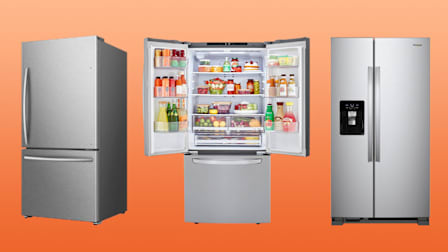8 Best French-Door Refrigerators of 2026, Lab-Tested by Our Experts
The top French-door refrigerators—from brands like GE, LG, and Whirlpool—ace tests for thermostat performance and temperature uniformity
When you shop through retailer links on our site, we may earn affiliate commissions. 100% of the fees we collect are used to support our nonprofit mission. Learn more.

Have sleek French-door refrigerators been catching your eye in the appliance aisle? If so, you’re in good company. These stylish models have become one of the most popular configurations. CR’s latest member survey reveals that French-door refrigerators account for more than half of new refrigerators bought by our members; no other refrigerator style comes close.
French-door refrigerators are generally bigger than top-freezer and bottom-freezer models, with more usable space, and they come loaded with more features, such as icemakers, digital controls, and spillproof shelves.
- Best French-Door Refrigerators by Width: 30-inch 33-inch 36-inch
- How CR Tests Refrigerators
Best 30-Inch-Wide and Narrower French-Door Refrigerators
The narrowest French-door models are around 30 inches wide. These models earn high marks for thermostat performance and temperature uniformity.
Best 33-Inch-Wide French-Door Refrigerators
There are relatively few 33-inch French-door refrigerators on the market, but some kitchens simply can’t fit a full-sized refrigerator. Three of the top five models in our ratings are from LG. French-door refrigerators of this size operate more efficiently than 30-inch models, and they get you much more storage space: as much as 25 cubic feet compared with 22 cubic feet for the roomiest 30-inch models.
Best 36-Inch-Wide French-Door Refrigerators
These refrigerators score higher overall in our ratings, thanks in part to their larger capacities—up to 29 cubic feet—which helps them be more energy-efficient.
How CR Tests Refrigerators
We rate refrigerators based on their thermostat performance, temperature uniformity, noise output, ease of use, energy efficiency, crisper performance, and icemaker performance (if they have one).
Every refrigerator we test gets wired with 15 temperature sensors. We then monitor those thermocouples for more than a month in one of three temperature-controlled chambers, collecting more than 5.4 million temperature readings for each fridge we test. The results tell us how well a refrigerator maintains a set temperature and how temperature varies in different areas of a fridge, so we can determine which models will keep your food fresh longer.
Our testers measure the noise when the compressor starts up and the steady hum while the fridge is running. For ease of use, we examine the fridge’s layout, controls, and lighting.
Our process includes tests for icemaker performance based on how much ice a fridge produces per day and how much it can hold in its reservoirs. We evaluate crisper performance to judge how well the crisper drawers retain moisture to keep your food fresh for longer periods of time.
We also factor in survey data from thousands of CR members to judge brand reliability and satisfaction. All of that data and more informs CR’s refrigerator ratings and each model’s Overall Score.
Learn more about CR’s refrigerator tests.
































